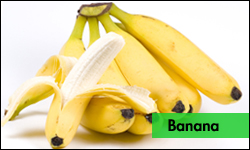Back to > Major Fruits | Minor Fruits | Underutilized Fruits
![]()
 |
|
|
Introduction:
Banana is one of the most important commercial tropical fruits traded. Eve was said to have used banana leaves to cover he modesty in the Garden of Paradise as revealed from antiquity. Banana is thus called “Apple of Paradise”. It is also known as “Adam Fig”. Banana is a type of fruit from herbaceous plants of the genus Musa. Musa species grow in a wide range of environments and have varied human uses, ranging from the edible bananas and plantains of the tropics to cold-hardy fiber and ornamental plants. They have been a staple of the human diet since the dawn of recorded history. These large, perennial herbs, 2–9 m in height, evolved in Southeast Asia, New Guinea, and the Indian subcontinent, developing in modern time is secondary loci of genetic diversity in Africa, Latin America, and the Pacific. Musa species attained a position of central importance within Pacific societies: the plant is a source of food, beverages, fermentable sugars, medicines, flavorings, cooked foods, silage, fragrance, rope, cordage, garlands, shelter, clothing, smoking material, and numerous ceremonial and religious uses. Although mostly consumed locally in the Pacific region, the fruit enjoys a significant worldwide export market. They are cultivated primarily for their fruit, and to a lesser extent for the production of fibre and as ornamental plants. Bananas come in a variety of sizes and colors when ripe, including yellow, purple and red. Most production for local sale is of green cooking bananas and plantains, as ripe dessert bananas are easily damaged while being transported to market.
Although the wild species have fruits with numerous large, hard seeds, virtually all culinary bananas have seedless fruits. Bananas are classified either as dessert bananas (meaning they are yellow and fully ripe when eaten) or as green cooking bananas. Bananas can be eaten raw though some varieties are generally cooked first. Bananas are a valuable source of vitamin B6, vitamin C, and potassium. Almost all export bananas are of the dessert types; however, only about 10–15% of all production is for export, with the United States and European Union being the dominant buyers.
Origin:
The exact of origin of banana is unknown; however some said that the true origin of this world’s most popular fruit is found in the Indo-Malaysian region reaching to northern Australia. Nowadays, banana is found throughout the tropics and subtropics. All edible bananas orginate in whole or in part from Musa acuminata which is native to the Malay Peninsula and adjacent regions.
Crop Status:
Bananas are grown in at least 107 countries.Although the wild species have fruits with numerous large, hard seeds, virtually all culinary bananas have seedless fruits. Bananas are classified either as dessert bananas (meaning they are yellow and fully ripe when eaten) or as green cooking bananas. Almost all export bananas are of the dessert types; however, only about 10-15% of all production is for export, with the United States and European Union being the dominant buyers.
In popular culture and commerce, “banana” usually refers to soft, sweet “dessert” bananas. The bananas from a group of cultivars with firmer, starchier fruit are called plantains. Bananas may also be cut and dried and eaten as a type of chip. Dried bananas are also ground into banana flour.
Half of the world’s banana crops are grown in Asia, and much of the produce is used locally. The leading banana-export regions are Central America and northern South America.
Main agro-forestry uses: Crop shade, mulch, living fence.
Main products: Staple food, fodder, fiber.
Yields: Up to 40,000 kg of fruit per hectare annually in commercial orchards.
Intercropping: Traditionally grown in mixed cropping systems throughout the Pacific.
Invasive potential: Banana and plantain are not considered to be invasive. Musa nonetheless is a persistent plant that competes relatively well with other species within managed agroforestry settings.
Scientific classification: Bananas make up the genus Musa of the family Musaceae. The plantain, or cooking banana, is classified as Musa paradisiaca. The Manila hemp is classified as Musa textilis.
Reference:
- Englberger, L. 2003. Carotenoid-rich bananas in Micronesia. InfoMusa 12(2): 2–5.
- “FAOSTAT: ProdSTAT: Crops”. Food and Agriculture Organization. 2005.
http://faostat.fao.org/site/567/DesktopDefault.aspx?PageID=567. Retrieved on 09-12-2006. - http://agroforestry.net/tti/Musa-banana-plantain.pdf
- http://www.ctahr.hawaii.edu/nelsons/banana/
- Kepler, A.K., and F.G. Rust. 2005. Bananas and Plantains of French Polynesia. Part I Traditional Non-Fe‘i Bananas: Descriptions, color photographs, status, and possible kinships with Hawai‘i’s ancestral bananas. Part II Color photographs of Western introduced Varieties. Part III Names & Synonyms of Extant and Recently Extirpated Varieties, Tahiti & the Marquesas Islands. Part IV Traditional Non-Fe‘i Banana Varieties, Society and Marquesas Islands: Known Historical Names, Meanings, and Locations dating back to the mid-19th Century. Part V Appendices. Unpublished.
- Lassoudiere, A., 1974. La mosaïque dite a tirets du bananier Poyo en Cote d’ Ivoire. Fruits,. 29: 349-357. Page 4. Int. J. Virol, 3 (2): 96-99.
- Lockhart, B.E. 1986. Occurence of canna yellow mottle virus in North America. Phytopathology 76: 995.
- Nelson, S.C., R.C. Ploetz, and A.K. Kepler. 2006. Musa species (bananas and plantains), ver. 2.2. In: Elevitch, C.R. (ed.). Species Profiles for Pacific Island Agroforestry. Permanent Agriculture Resources (PAR), Hōlualoa, Hawai‘i. <http:// www.traditionaltree.org>
- Olorunda AO, Aworh OC. 1984. Effects of Tal Prolong, a surface coating agent, on the shelf life and quality attributes of plantains. Journal of the Science of Food and Agriculture 35: 573-578.
- Rene Rafael C. Espino, Ph. D., et al, 2000.Banana Production.“Tracing antiquity of banana cultivation in Papua New Guinea”. The Australia & Pacific Science Foundation. http://apscience.org.au/projects/PBF_02_3/pbf_02_3.htm. Retrieved on 2007-09-18
- Yueming Jiang1, , Daryl C. Joyce3, Weibao Jiang4 and Wangjin Lu. 2004. Effects of Chilling Temperatures on Ethylene Binding by Banana Fruit Plant Growth Regulation 43: 109–115, 2004.Kluwer Academic Publishers. Printed in the Netherlands.
